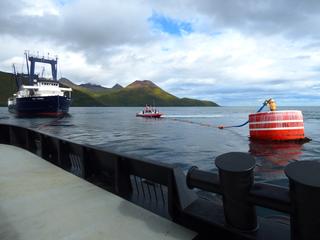Towing Drill Tests Emergency Mooring Buoy

Tuesday, September 16 2014

The Sea Trader (left), seen from the deck of the tug James Dunlap, waits to be tied on to Unalaska's emergency mooring buoy. At center, the city's harbor patrol boat stands by to assist. (Annie Ropeik/KUCB)
After seven years, Unalaska’s emergency system for towing stranded vessels away from shore is finally complete. A new dedicated buoy for disabled ships got its first full-scale test during an annual drill last week.
For tugboat captain Leonardo Asayama-Lucena, conditions couldn't have been better: clear skies, calm seas and next to no wind.
"This is the best-case scenario: the weather is perfect, the boats aren’t drifting around too much," Lucena said during last week's drill. "It’s not gonna get any easier."
A real-life rescue might happen at night, or in a storm -- but this morning is just a drill, the first one Lucena and his tugboat, the James Dunlap, have been a part of.
"It definitely breaks the monotony of our daily routine that we usually have," he says. "I’m actually glad we’re doing it, because in the event of an actual emergency, you know, practice makes perfect, so we could all use this practice."
The Dunlap is going to use Unalaska’s equipment to help the Coast Guard tow a fake-stranded vessel to safety. The 277-foot freighter Sea Trader is acting as the disabled ship. It’s supposed to end up at Unalaska’s new emergency mooring buoy, which has been in place since late 2012, but wasn’t ready for a major test until now.
[USCGC Alex Haley crew member on radio]: Sea Trader, Alex Haley. Just got word the helo should be airborne in about five to 10 mikes...
That’s the Coast Guard cutter Alex Haley, talking to the Sea Trader on the tugboat’s radio. All three vessels are sitting out in Unalaska Bay, getting ready to start the drill.
The Alex Haley’s helicopter has to drop the emergency tow package onto the Sea Trader. Then, the freighter will use it to link up with the cutter.
[helicopter hovering]
It’s a tight fit, but the helicopter sticks the delivery. The Sea Trader’s crew starts working on connecting to the cutter. And that’s Capt. Lucena’s cue to wake up his deckhands.
Lucena [speaking to crew member]: Hey, John, if you wouldn’t mind -- once they get their eyes open and coffee down the hatch, have ‘em come up here and we’ll all have a little meeting...
In a real situation, the Coast Guard would tow the disabled ship to the James Dunlap. Then, the tug would hook on and take the vessel to the mooring buoy. The Coast Guard’s just practicing setting up its tow line today -- but the James will be doing the real thing.
Adam Downing is a deckhand on the tug. He’s glad for the chance to try out the emergency system.
"I mean, it’d be crazy not to have one of these, I think," he says. "Because if anything happens, like, you get those big ships out there, you’re asking for a catastrophe."
As growing industries bring more ship traffic to the Aleutians, that risk is on the rise -- and so is the need for practice. Today, Capt. Lucena and his crew will try out a tool they haven’t used before. It’s Unalaska’s line gun, a rifle for shooting a tow line to another ship.
Lucena [speaking to crew]: You know, just take our time. I’m gonna position ourselves -- basically like this but closer, off the starboard bow of the Sea Trader, using the wind to help us shoot it over the bow. You can see, you’ve got lots of room -- don’t aim for the house. [crew laughs]
With the Coast Guard out of the way, the tugboat sounds its horn to let everyone know the shot is coming.
[horn blasts] [gun firing]
The tow line sails over the Sea Trader and drops onto it deck. Now the freighter can tie on to the tug, and together, they can head for the mooring buoy. It’s floating offshore like a big plug in a bathtub drain. Lucena explains that it gives disabled ships a safe place to await repairs.
"So they would hang out there on this long tow line to the buoy, and they can spin around the buoy in deep water and not have to worry about going around," he says. "And when the weather subsided, if they still weren’t able to get underway on their own power, they would … just attach themselves directly to the mooring buoy, and we’d take the tow line away."
Even in the best conditions, though, things can still go wrong. When the ships get to the buoy, they find a soggy mooring line that’s a little tough to wrangle. But in the end, they get the Sea Trader tethered, and for Lucena, the drill is a success.
"Especially for me, this being my first time, I learned a lot. And I can now pass that on," he says. "Knowing what to expect when you get into this ... makes it quicker and just gives you that much better level of safety."
And all those lessons will go to make the buoy and the whole towing system better in the future -- whether for a real emergency, or just next year’s drill.


